An essential factor in any type of food-processing system is a conveyor to facilitate the best productivity and efficiency possible. The right setup will consolidate your operations and reduce labour while cutting costs and boosting output. To make sure you have the best food conveyor systems for your setup here are some things to consider.
Sanitation Awareness
Food production equipment requires excellent sanitation, so conveyors are needed that reduces the chance of contamination. Conveyors are usually made using stainless steel and are efficient in handling high-pressure washings. They’re also easy to clean and have no crevices where bacteria will easily grow.
Easy Cleaning
When washing down a conveyor system having enclosed motors, spray bars, belt lifters, and other components will help make it a lot easier. It is therefore helpful to keep these elements in mind when selecting a system.
Safety Features
Safety is always a high priority when handling any type of processing equipment. Make sure to choose a food conveyor with narrower surfaces, appropriate shutoff switches, safety guards, and ergonomic design to reduce the chance of worker injury and comply with safety regulations.
Durable Construction
Food processing is a long and on-going process, putting plenty of hard hours on equipment with minimal downtime and little chance of slowing down. Conveyors must be able to run at maximum speed and capacity at all times, so durable construction is a must. Your conveyor must stand up against constant use and frequent cleanings with materials that are harder to damage, such as steel.
Low Maintenance
Just as durability is necessary to make sure a conveyor system can withstand on-going usage requirements; low maintenance needs are also important for minimising downtime. When a conveyor system is down for maintenance, it impacts the efficiency and productivity of your whole company and lowers revenue. Some maintenance is unavoidable but regular repairs add up, so opt for low maintenance conveyors to make the most of your system.
Belting Types
The type of belt you choose depends on the products you’re manufacturing. Slippery or wet foods will require a system that is set up with mesh belting. Whereas dry and solid foods are better on a system with solid belts. A roller belt is also helpful in some situations so that food can be sorted, aligned, and merged automatically.
Throughput Capacity
This may seem like an obvious element to think about but considering throughput capacity when choosing a food conveyor system is important, as having a system incapable of keeping up with the necessary product output will never allow you to achieve optimal operational efficiency. Or it would put extreme pressure on the system leading to additional maintenance and downtime.
Here at Asmech Systems, we supply many different types of conveyors suitable for all sectors of the food industry. If you are looking for a conveyor system and want to discuss your requirements with a knowledgeable expert team, please contact us on 01623 424442 or sales@asmechsystems.co.uk









